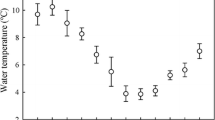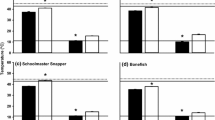Abstract
To optimize habitat characteristics when managing resident and migratory stream fish populations in regulated systems, it is important to know a species’ preferred temperatures. However, temperature-preference devices used in many laboratory studies often have design limitations (e.g., confounding variables such as differential light intensities or water depths, or perceived cover) limiting their usefulness. To overcome these design limitations, we constructed a 3-m-diameter, annular preference apparatus made of clear, acrylic plastic capable of presenting uniform light intensities, constant water depths and velocities, and stable vertical and horizontal temperature gradients for experimental fish. We determined preferred temperatures of hardhead Mylopharodon conocephalus (mean TL: 36.2 cm) and rainbow trout Oncorhynchus mykiss (mean TL: 35.4 cm) acclimated to 12, 15, and 18 °C and tested, individually, in the 12–24 °C annular gradient. All hardhead acclimation groups avoided waters <17 °C, whereas trout acclimated to 12 and 15 °C consistently avoided water >19 °C, and 18 °C acclimated trout avoided water temperatures <16 °C and >20 °C. Including all acclimation temperature groups, mean hardhead preferred water temperatures ranged from 19.6 °C to 21.0 °C (mean modal preferences were 20.2–21.5 °C), whereas trout preferred significantly cooler average water temperatures ranging from 16.0 °C to 18.4 °C (mean modal preferences were 15.8–18.5 °C). These temperature preference data can be used to guide regulation of stream systems for key fish species.






Similar content being viewed by others
References
Baltz DM, Vondracek B, Brown LR, Moyle PB (1987) Influence of temperature on microhabitat choice by fishes in a California stream. Trans Am Fish Soc 116:12–20
Behrens JW, Grans A, Therkildsen NO, Neuenfeldt S, Axelsson M (2012) Correlations between hemoglobin type and temperature preference of juvenile Atlantic cod Gadus morhua. J Exp Mar Biol Ecol 4113:71–77
Beitinger TL, Magnuson JJ (1976) Low thermal responsiveness in the bluegill, Lepomis macrochirus. J Fish Res Board Can 33:293–295
Cech JJ Jr, Mitchell SJ, Castleberry DT, McEnroe M (1990) Distribution of California stream fishes: influence of environmental temperature and hypoxia. Environ Biol Fish 29:95–105
Cocherell SA, Cocherell DE, Jones GJ, Miranda JB, Thompson LC, Cech JJ, Klimley AP (2011) Rainbow trout Oncorhynchus mykiss energetic responses to pulsed flows in the American River, California, assessed by electromyogram telemetry. Environ Biol Fish 90:29–41
Cooper JJ (1983) Distributional ecology of native and introduced fishes in the Pit River system, northeastern California, with notes on the Modoc sucker. Calif Fish Game 69:39–53
Coutant CC (1987) Thermal preference: when does an asset become a liability. Environ Biol Fish 18:161–172
Fangue NA, Podrabsky JE, Crawshaw LI, Schulte PM (2009) Counter gradient variation in temperature preference in populations of killifish Fundulus heteroclitus. Physiol Biochem Zool 82(6):776–786
Gard MF (2004) Interactions between an introduced piscivore and a native piscivore in a California stream. Environ Biol Fish 71:287–295
Gräns A, Olsson C, Pitsillides K, Nelson HE, Cech JJ Jr, Axelsson M (2010) Effects of feeding on thermoregulatory behaviours and gut blood flow in white sturgeon (Acipenser transmontanus), using biotelemetry along in combination with standard techniques. J Exp Biol 213:3198–3206
Jobling M (1981) Temperature tolerance and the final preferendum: rapid methods for the assessment of optimum growth temperatures. J Fish Biol 19:439–455
Jobling M (1994) Fish bioenergetics. Chapman and Hall, London, p 309
Klimley AP, Cech JJ Jr, Thompson LC, Hamilton SA, Chun S (2006) Experimental and field studies to assess pulsed, water flow impacts on the behavior and distribution of fishes in the South Fork of the American River. University of California, Davis, report to the California Energy Commission, PIER Energy-Related Environmental Research. CEC-500-2005-172
Knight NJ (1985) Microhabitats and temperature requirements of hardhead (Mylopharodon conocephalus) and Sacramento Squawfish (Ptychocheilus grandis), with notes for some other native California stream fishes. Doctoral dissertation. University of California, Davis
Licht P, Dawson WR, Shoemaker VH (1969) Thermal adjustments in cardiac and skeletal muscles of lizards. J Comp Physiol 65A:1–14
McMahon TE, Bear EA, Zale AV (2008) Use of an annular chamber for testing thermal preference of westslope cutthroat trout and rainbow trout. J Freshw Ecol 23:55–63
Moyle PB (2002) Inland fishes of California. University of California Press, Berkeley, 502 pp
Moyle PB, Nichols RD (1973) Ecology of some native and introduced fishes of the Sierra Nevada foothills in central California. Copeia 478–490
Myrick CA, Cech JJ Jr (2000) Temperature influences on California rainbow trout physiological performance. Fish Physiol Biochem 22:245–254
Myrick CA, Folgner DK, Cech JJ Jr (2004) An annular chamber for aquatic animal preference studies. Trans Am Fish Soc 133:427–433
Pankhurst NW, Thomas PM (1998) Maintenance at elevated temperatures delays the steroidogenic and ovulatory responsiveness of rainbow trout Oncorhynchus mykiss to luteinizing hormone releasing hormone analogue. Aquaculture 166:163–177
PGE (Pacific Gas and Electric) (2005) Flow and fluctuation in the reach downstream of Chili Bar Technical Report. Sacramento Municipal Utility District Upper American. FERC Project No. 2155 and No. 2101
Reynolds WW (1977) Temperature as a proximate factor in orientation behavior. J Fish Res Board Can 34:734–739
Salinger DH, Anderson JJ (2006) Effects of water temperature and flow on adult salmon migration speed and delay. Trans Am Fish Soc 135:188–199
Schurmann H, Steffensen JF, Lomholt JP (1991) The influence of hypoxia on the preferred temperature of rainbow trout Oncorhynchus mykiss. J Exp Biol 157:75–86
Thompson LC, Escobar MI, Mosser CM, Purkey DR, Yates D, Moyle PB (2011) Water management adaptations to prevent loss of spring-run Chinook salmon in California under climate change. J Water Resour Plan Manag. doi:10.1061/(ASCE)WR.1943-5452.0000194
Young PS, Cech JJ Jr, Thompson LC (2011) Hydropower-related pulsed-flow impacts on stream fishes: a brief review, conceptual model, knowledge gaps, and research needs. Rev Fish Biol Fish 21(4):713–731
Acknowledgments
We thank S. Hamilton for project coordination and fish collection. T. Reid, C. Myrick, S. Chun, M. Fish, D. Kratville, C. Woodley, G. Soyster, N. Pham, and R. Kaufman for advice and technical support; A. Kay for extensive laboratory assistance; P. Lutes and E. Hallen from the UC Davis Center for Aquatic Biology and Aquaculture for technical assistance; V. de Vlaming for manuscript review; California Department of Fish and Game’s American River Trout Hatchery for trout; the Pulsed-Flow Program Management, Team especially J. O’Hagan, J. Canaday, D. Conklin, and P. Young for guidance; and the Public Interest Energy Research Program of the California Energy Commission (Contract No. 500-01-044) and the UC Davis Agricultural Experiment Station (grant no. 2098-H to NAF) for financial support. All handling, care and experimental procedures used were reviewed and approved by the UC Davis Institutional Animal Care and Use Committee (IACUC Protocol 16832).
Author information
Authors and Affiliations
Corresponding author
Rights and permissions
About this article
Cite this article
Cocherell, D.E., Fangue, N.A., Klimley, P.A. et al. Temperature preferences of hardhead Mylopharodon conocephalus and rainbow trout Oncorhynchus mykiss in an annular chamber. Environ Biol Fish 97, 865–873 (2014). https://doi.org/10.1007/s10641-013-0185-8
Received:
Accepted:
Published:
Issue Date:
DOI: https://doi.org/10.1007/s10641-013-0185-8




